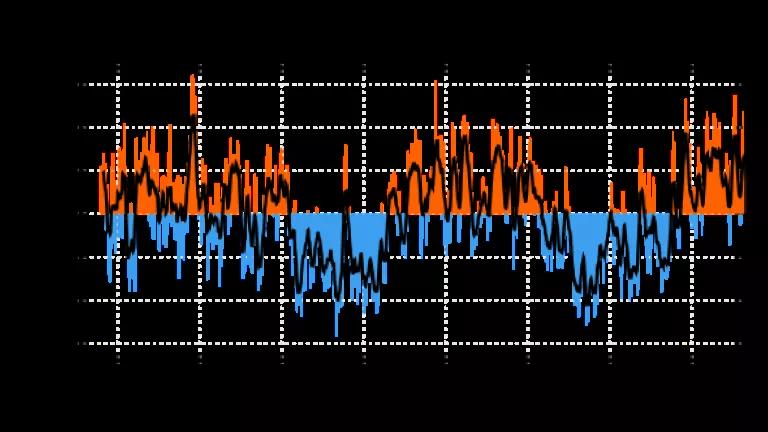A Variation Variable
Unraveling the Atlantic Multidecadal Oscillation will help us better understand climate change.

Atlantic Multidecadal Oscillation (n.): long-term, periodic changes in the temperature of the Atlantic Ocean surface waters
Some of the most important research on climate change right now isn’t on climate change at all. Here’s what I mean: Every time an extreme weather event strikes, a debate ensues about whether manmade climate change caused the incident or if it was the result of “natural variability.”
There’s a big problem with this argument. We know a lot about climate change but very little about natural variability—the complex system that dictated all weather before humans intervened with our carbon emissions. As a result, the burden of proof falls on those arguing that climate change caused a storm or drought. If they can’t prove that human activity directly caused the event, it falls into the big black box labeled “natural variability.” No one asks for proof that natural variability caused an extreme event, and only in rare cases, such as the California drought, does such evidence exist.
If we better understood the natural forces that drove changes in the earth’s climate for the last 4.5 billion years, we could have a more informed discussion about how to attribute extreme weather events to either natural variability or anthropogenic climate change. To that end, we need more research on ocean currents, variations in solar intensity, volcanic eruptions, and other natural phenomena. That research is only starting to dribble out. Today, researchers at the U.K.’s National Oceanography Centre published a study explaining the forces that drive the Atlantic Multidecadal Oscillation.
“Atlantic Multidecadal Oscillation” is a mouthful, but if you go slowly and sound it out, it’s actually pretty self-explanatory. The temperature at the surface of the Atlantic Ocean fluctuates between warm and cool. These swings of approximately one degree Fahrenheit have historically occurred every 20 to 40 years.
Oceanographers can prove that this phenomenon has occurred for at least 1,000 years, but there has been disagreement about what causes it. The prevailing theory is that underlying currents in the Atlantic produce the temperature changes, but volcanic activity, airborne particles emitted by humans, and dust from Africa have also been blamed. In addition, we can’t yet predict when exactly the AMO will switch from warm to cold or vice versa. These are crucial knowledge gaps in climatology.
One of the goals of historical climate models is to isolate carbon dioxide as a variable. Changes in sea-surface temperature introduce stray variables into those equations. This uncertainty is also a big problem for forecasters. Remember the so-called “pause” in global warming, which climate change deniers wrongly claim disproves the entire theory of anthropogenic climate change? That was the result of forecasting uncertainty, due in large part to our poor understanding of how the oceans will behave a decade or two in the future.
In today’s study, researchers used sea-level measurements to prove that deep-ocean currents do, indeed, put the “O” in AMO. This step forward doesn’t answer all the questions we have about the oscillation, but it provides a platform for future researchers to determine more precisely how the AMO behaved in the past and to forecast how it will behave in the future.
Here’s why all this matters. The AMO has profound impacts on the North American climate. When the AMO is in a warm phase, as it is now, it contributes to drought in the Midwest and Southwest. The AMO was a primary driver of the 1930s Dust Bowl, one of the worst droughts in U.S. history. AMO warm phases also help tropical storms develop into hurricanes. Data from the mid-20th century suggests we see about twice as many hurricanes during the AMO warm phase as during a cool phase. Since a cool ocean surface absorbs more heat from the atmosphere than a warm ocean surface, the AMO can also either mask the impacts of anthropogenic climate change or make them appear worse than they actually are.
Studying the AMO may not seem like climate change research, but it is. The climate is a massive, complicated system. It’s impossible to understand how humankind is affecting that system without understanding how it would behave without our contribution. Or to put it another way: All climate research is now climate change research.
This article was originally published on onEarth, which is no longer in publication. onEarth was founded in 1979 as the Amicus Journal, an independent magazine of thought and opinion on the environment. All opinions expressed are those of the authors and do not necessarily reflect the policies or positions of NRDC. This article is available for online republication by news media outlets or nonprofits under these conditions: The writer(s) must be credited with a byline; you must note prominently that the article was originally published by NRDC.org and link to the original; the article cannot be edited (beyond simple things such grammar); you can’t resell the article in any form or grant republishing rights to other outlets; you can’t republish our material wholesale or automatically—you need to select articles individually; you can’t republish the photos or graphics on our site without specific permission; you should drop us a note to let us know when you’ve used one of our articles.

How to Become a Community Scientist
Ocean Acidification: What You Need to Know
Biodiversity 101